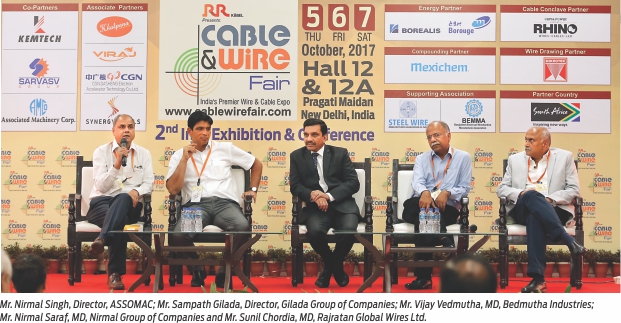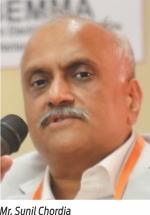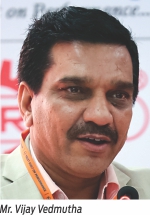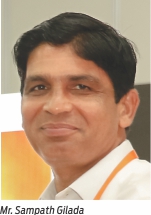Low per capita steel consumption, low infra investment, tax and labor reforms, quality and productivity, innovation, productive employee base, etc. are some of the persistent issues faced by the steel wire industry in India. The steel wire industry leaders discussed some of these issues in detail at Cable & Wire Fair 2017 conference.
A CEO panel discussion, exclusively for the Indian steel wire sector, was held at CWF17 to highlight potentials, issues, and trends in from the perspectives of major players in this important industry. The panel included Mr. Nirmal Saraf, Managing Director, Nirmal Group of Companies; Mr. Vijay Vedmutha, Managing Director, Bedmutha Industries; Mr. Sunil Chordia, Managing Director, Rajratan Global Wires Ltd; and Mr. Sampath Gilada, Director, Gilada Group of Companies. The discussion was moderated by Mr. Nirmal Singh, Director, ASSOMAC.
The discussion was largely focused on quality and productivity issues coupled with some usual ones such as tax and labor reforms, the importance of innovation, safety, etc. Amid discussion, everyone unanimously expressed that the industry is optimistic of more investments on infra fronts generating requisite demand for the industry. The panelists though agreed that improvements have been seen in wire drawing technology and speed of the machines, they also expressed that the focus must always be on the quality of machines, dies, tools, and every other thing in the workplace.
The Steel Consumption to Grow with Economy
Mr. Sunil Chordia of Rajratan Global Wires started speaking with a brief overview of his company and how it became a trusted steel wire brand globally in matter of no time because of continuous focus on innovation and quality. He said that the Indian steel wire market is quite big and upcoming and the world is looking at it. “For the last few years, the world’s focus is on India because of the huge consumption base. India’s population is what makes it attractive for the world to think of it as a big market. Of course, things are not happening the way we would like it to go. But, the Govt. is working towards solving the issues of infrastructures, tax reforms, and labor reforms, which I believe would put the industry on right track.”
Mr. Chordia said that more investments are likely follow because steel is the basic need of any nation. If any economy has to grow, the steel consumption will grow in multiples, he added. He though agreed that the consumption of steel products, including steel wire, is below global average, he also asserted that the industry is expecting a quantum increase in the consumption of wire products in India. “Now, the question is how we prepare ourselves for the growth and take advantage of being in the Indian market,” he said.
“The biggest focus should be on the quality of the product; you should make the right quality because most of the wire products are consumed keeping safety in mind. No customer is ready to compromise on the safety aspect of the product he is using. If there are some technical problems, which resulted in the failure of a wire, I think no customer will accept your product,” he explained.
“If we are using good machines and focusing on quality, my belief is that the cost will come down automatically. Making good quality is always cheaper than making a bad one.”Mr. Chordia emphasized the need of better technology if quality and productivity have to be addressed. “We have seen a lot of innovations in manufacturing in recent times; not only in manufacturing, but also lots of improvements have been seen in wire drawing technology and speed of the machines. The technologies have reduced the cost of electricity and have improved the quality considerably,” he added.
Speaking further on cost control, he said, “ Many people from the industry may not agree but I firmly believe that if we make a good quality product, our cost comes down. This will consequently help you to reach the global market.” Mr. Chordia explained how competing in global market would tremendously improve the quality parameters as many customers outside the country are quite particular about the quality.
“There are challenges regarding the right quality of raw material. Even though the right quality of raw material is available in India, it is not enough. The talent pool is not available and we must always train people. We have trained many people. A lot of people are learning a lot while working with us. This will keep happening in any growing company, nation or market. We are part of the process,” said Mr. Chordia.
Go Beyond Normal to Realize Quality!
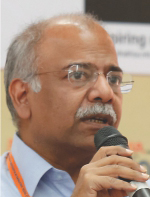
“Quality is my utmost objective; it is important that we have quality,” said Mr. Nirmal Saraf opening his speech at the discussion. “However, how to get the desired quality is another issue. One must go beyond his normal or routine processes to attain quality. Go to demanding customers and see what they want! Unless the customer tests the quality of a certain product from a particular manufacturer, he would not become demanding. Meeting the demands of such customers is something which is going to put Indian steel wire industry aside from the rest in terms of quality. In the long run, it is the quality, which is going to win,” he added.
Mr. Saraf delineated more on how to attain the consistent quality quotient in the production process and said quite insightfully that everything related to quality ensues from a thought process. A producer first has to start thinking in terms of quality, which will lead to efforts made in elimination of error, and documentation of all processes, eventually resulting in desired quality, he added. He further talked about a quality culture and ensuring good work environment at the organizational level to ensure quality control. “It starts with giving a very good work environment to your people so that they can work well and with full energy. The big challenge which most of us are facing today is that most of the youngsters would like to work in a computer-controlled environment instead of going to the shop floor,” he said.
Mr. Saraf suggested leveraging IT and IT enables services to facilitate processes at the work place. “We should design our workplace such that most of the manual work is automated. Reporting should be mobile based and there should be apps for doing all the reporting. It’s a blessing for us that the young generation is quite comfortable with the technology. We should make the working environment according to the workmen. Apart from this, your internal standards will help you enhance your quality standards. We should try to exceed the customer’s expectation, not only in the terms of quality of the product but also the quality of service we provide by becoming customer-centric,” he asid.
As envisaged in the National Steel Policy 2017, India is targeting the production of 300 million tonnes of steel by 2030. At present, India produces 90 mt of steel per annum. Reflecting on this fact, Mr. Saraf said, “With India aiming to produce 300 million tonnes of steel, which is thrice what we produce today, the wire consumption and production will triple as well. With the bonus of having such a huge market where we can operate in volumes, we should leverage that to build up the export capacities. India has become a competitive market where every other country is looking at India sources. But it (India) does lack in the packaging of the product, the focus on quality, and customer service.”
Speaking further the export of Indian steel products, Mr. Saraf further said, “The biggest complaint I heard from overseas customers is about the delivery schedules, which the customers feel the Indian companies are not very serious about. These are certain issues which are solvable. Done that, I am sure the steel wire industry along with the steel industry can triple over the next 5-6 years.”
Quality Must Precede Price: An Awareness Goal
On quality aspect of steel wires in India, Mr. Vijay Vedmutha said, “There is one thing I am really proud of that we at Vedmutha Industries have always believed in quality product deliverance, and we have invested a lot into the latest technology with regards to that.”“With the hope that infra investments would happen at brisk rate, a lot of capacity has been added by the industry throughout the country and yet the demand has not been picked up.”Speaking about sluggish demand scenario with respect to over-capacity in the market, Mr. Vedmutha said, “The long-term prospect of the industry is very good, but in the short-term, there are many challenges which the industry is passing through. ” He added that things would however improve with the structural changes being envisaged by both the Govt. and industry.
Mr. Vedmutha spoke further on the quality issue and suggested that apart from making good quality product, making end-users quality conscious is also necessary. “The wire industry as a whole on a collaborative basis needs to educate the end-users. The users need to be asked about what they understand about quality as a term, the uses of quality, and the advantages they are going to get after using quality products,” he added.
On the public sector procurement policy, Mr. Vedmutha suggested to introduce the quality parameter as primary benchmark in place of lowest price. “I feel that the public sector is one of the major buyers of the wires as wire goes into basic infrastructures like schools, roads, and many other places. There is a tendency towards L1, i.e. awarding the contract to lowest price bidder and L1 means compromise with quality. We have to create the awareness among the user industries and the public sector particularly where the criteria for buying is through tenders. This is one issue I feel the steel wire industry as a whole has to collaboratively look forward to addressing in the near term,” he said.
“The Indian wire industry today is at par with the world industry as far as speeds and processes are concerned; we used to have a problem with the availability wire rods, but that is also available now in the country. The only requirement is that demand has to come up and the end user needs to be made aware of the quality parameters,” concluded Mr. Vedmutha.
The Need to Go Beyond BIS
Taking the talk on quality issue further, Mr. Sampath Gilada said, “We need to see the world standards for steel and its products, and should develop such a standard which meets the international quality specifications enabling us to export more.”
Mr. Gilada spoke further on how to increase of export share, “Chennai is not as competitive as it was earlier. Now, Chennai instead of exporting the wire rods started importing. This though is sad yet brings an opportunity for the Indian steel wire industry to export to so many unexplored markets, which was not possible earlier. Even selling to Bangladesh itself was a big challenge, even for the people from Bengal because of the Chinese competition. Now, they are exporting in large number to Bangladesh and East Africa. Also, all such markets are opening up for the Indian wire industry.”
Mr. Gilada also explained how the Indian steel wire industry has been growing lately, especially in some of the understated segments, “The ribbed wire, which is being made in extremely small quantities in India, has a very good potential. It can be widely used and can definitely replace rebar in a competitive fashion. The ribbed wire is used all over the world for its better quality and a perfect size and quality matrix than the hot-rolled rebars. It can also be set up in various growth centers where it is consumed,” said Mr. Gilada. “And the same rebars can be used in the construction industries where we can bend and weld. The bending and welding on a large scale are the only ways through which international projects are done faster because they are having this technology where India is not yet coming up to that level.”
Mr. Gilada said that the Indian steel wire industry should be aware of such untapped segments, where the industry can definitely kick on giving the huge potential and demand. He also appealed to the steel wire industry associations to start training institutes, which will actually solve manpower issues.
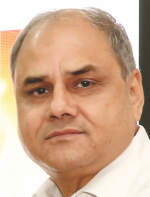
Mr. Nirmal Singh, Director, ASSOMAC agreed with the most of the points and said, “There are so many aspects like innovation and social responsibility on which we have to concentrate. The country is growing, the demand is growing, and there is no doubt that the infrastructural requirement of the country is going to grow.”
“It always comes with an innovative approach and the mindset of the people about their work. The machines may be very good, but then how your system works depends on the kind of skill set the man power possess.”
“The type of investment and the capacity building, which the industry has done in the last 3-4 years, is not met with adequate demands at present. Nevertheless, we are hopeful that in the future the demand will definitely go up,” summarized Mr. Singh and concluded the session.



